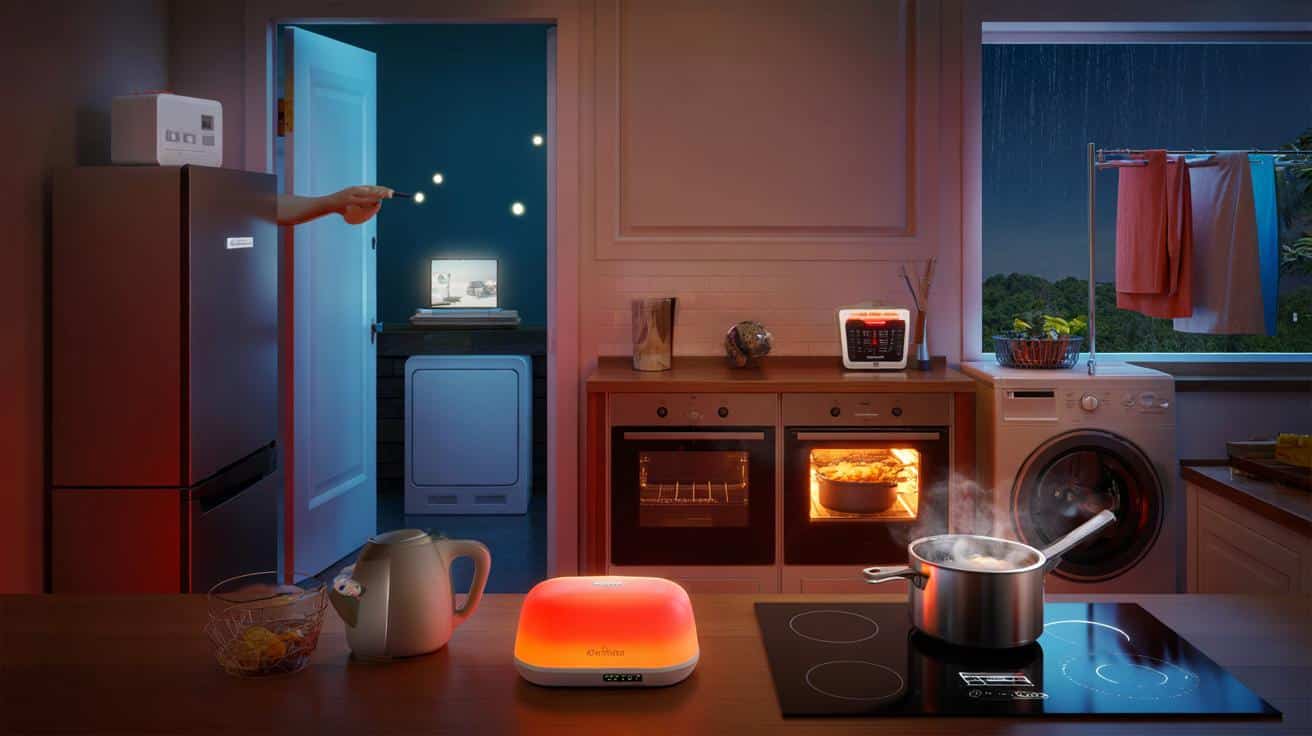The truth is, a handful of everyday appliances quietly munch through far more power than we think, while others hit your bill in dramatic, short bursts. The trick isn’t living colder or cooking less. It’s knowing what’s hungry, and using it smarter.
On a damp Sunday night, the kitchen does its usual orchestra: the low hum of the fridge, the click of the boiler, the urgent little whistle from the kettle. The smart meter on the counter pulses red as the tumble dryer pings done, and you can almost feel your wallet flinch. I open the fridge for a lazy stare, close it, then open it again without thinking. The display jumps each time we heat, cool, or blast. There’s a pattern buried in these tiny moments.
The quiet guzzlers hiding in daylight
Your biggest day‑to‑day drain isn’t always the loudest machine; it’s the chorus of **always-on appliances** ticking away. The fridge‑freezer, the Wi‑Fi router, the set‑top box, the baby monitor you forgot about—all tiny sips that never stop. A fridge might only draw a modest 100–200 watts when cycling, yet it works 24/7, so it adds up fast. Standby isn’t “off”; it’s a slow leak across every hour of your week.
Short, hot machines are the drama queens. The electric shower pulls 7.5–10.5 kW, so even eight minutes is a jolt you feel on the meter. Tumble dryers often burn 2–4 kWh per cycle, which at roughly 20–30p per kWh is real money for one load. In a shared flat I visited, four quick showers, two dryer runs and a roast with the oven door gaped open beat the week’s silent fridge tally in two evenings. You can watch the cost spike, then sink back to the hum.
Think in power and time. Big wattage over a short burst can rival small wattage across a whole day, and duty cycles matter—an appliance that cycles on and off is less scary than its peak suggests. Heat is the pricey part: heating water, heating air, heating ovens. Cooling also bites, though less violently. The more often a machine has to create or chase temperature, the more the bill climbs.
How to use less without living by candlelight
Cut the heat, keep the comfort. Wash at 30°C and use a higher spin so drying is quicker; line‑dry first, then a short dryer finish if you must. Clean lint filters and door seals so machines don’t fight grime. Cook with lids on, use an induction hob if you can, and favour the microwave or air fryer for small batches—*tea tastes the same whether you boil one cup or a full kettle.* Set the fridge to about 4°C and the freezer to −18°C, and leave space for air to circulate.
We’ve all had that moment when the meter lights up just as you switch everything on at once. Stagger your heavy hitters—don’t shower while the dishwasher and dryer are mid‑cycle, and avoid firing the oven and hob together for tiny meals. Defrost the freezer, dust the fridge coils, and keep door seals tight so cold air stays put. Let’s be honest: no one actually does that every day. Aim for two or three habits you’ll stick to, then add more when they feel normal.
Warm water timing matters, and so do the little routines that stick.
“Think in watt‑hours, not guilt. If it makes heat, shorten the time. If it runs all day, trim the hours.” — a veteran energy adviser I met on a housing estate audit
- Shorten showers by two minutes; electric showers are **short, hot bursts** that cost more than you think.
- Boil only what you need; kettles are 3 kW champions at wasting water you won’t drink.
- Batch‑cook in the oven once, reheat by microwave or air fryer for **real-world savings**.
- Use eco cycles; modern dishwashers and washers clean well at lower temps.
- Switch off standbys at the wall or via smart plugs with schedules.
- Close gaps: draught‑proof doors, bleed radiators, and don’t block them with sofas.
- Dry clothes on racks near airflow; finish in the dryer for 10 minutes if you like softness.
- Run power‑hungry jobs on off‑peak tariffs if your plan supports them.
Rethink your daily energy rhythm
The meter isn’t judging you. It’s a mirror of your routine. Most homes follow patterns—heat and light in the morning, cooking and hot water in the evening, always‑on kit filling the gaps. Match your habits to what the kit is best at. Chill one shelf lower in the fridge, not the whole kitchen; boil one mug, not the kettle; dry on air and finish with warmth, not the other way round. Tiny shifts multiply when they happen every week. Share what works in your home, borrow what works in someone else’s. The bill will notice first. You’ll feel it second.
| Key points | Detail | Reader Interest |
|---|---|---|
| Always‑on vs burst power | Fridges, routers and standbys sip constantly; showers, dryers and ovens gulp in short hits | Reveals the real culprits hiding behind “harmless” habits |
| Cook smart, not longer | Use lids, microwave or air fryer for small portions; batch‑cook once, reheat efficiently | Saves time on busy nights and cuts costs without bland meals |
| Laundry tweaks | 30°C washes, higher spin, line‑dry first, clean filters and seals | Immediate, visible savings with better‑smelling clothes |
FAQ :
- Which home appliance uses the most electricity day to day?Typically the fridge‑freezer across a whole day, because it runs 24/7. For short bursts, electric showers, tumble dryers and ovens are the heavy hitters.
- Is an air fryer cheaper to run than an oven?For small portions, yes. It heats less air and preheats fast, so you use fewer watt‑hours for the same result.
- Does switching off at the wall really save money?Yes. Standby loads can add up to tens of pounds a year. Smart plugs with schedules make it painless.
- What temperature should my fridge and freezer be?Fridge around 4°C, freezer around −18°C. Keep them reasonably full and let air circulate for steady cooling.
- When is the cheapest time to run appliances?If you’re on a time‑of‑use tariff (like Economy 7 or a smart plan), overnight or off‑peak periods are cheaper. If not, cost per kWh stays similar through the day.








